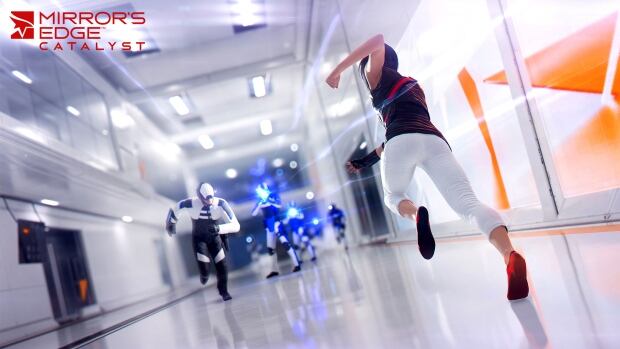Reception was mixed, owing mainly to a lacklustre storyline and clunky combat, so EA sat on the franchise for the better part of a decade. Fans of the game's unique mechanics and art direction have kept its memory alive since then.
- Battlefield 1 tackles First World War, a rare setting in video games
- The Sims 4 opens up gender customization options for gamers
- Why the Street Fighter e-sports community likes to keep it loud
Now developer DICE is wiping the slate clean with Mirror's Edge Catalyst, a reboot of sorts that tells a new origin story for lead character Faith Connors while expanding and refining the gameplay of the original.
Catalyst's City of Glass is one of the most recognizable settings in video games, all skyscrapers and right angles painted in lacquered white, highlighted with splashes of blue and yellow.
Gorgeous setting, pedestrian story
The story behind this ultra-modern landscape, sadly, is nothing special, providing the player just enough narrative justification for you to traipse around its rooftops and underground with aplomb.
Through bits of dialogue and audio diaries scattered throughout the space we learn that the city's been more or less segregated into a caste-like system: rich one-percenters rule over the lower and middle classes who generally don't get into trouble so long as they know their role and shut their mouths.

The City of Glass is an unusually bright and clean setting for a video game. (DICE/Electronic Arts)
You play as Faith Connors, a young woman who just got out of jail for unspecified delinquency. Her parents and sister were killed in a riot when she was seven years old, and since then she's lived with the Runners, a group of messengers-slash-thieves who broker information and stolen goods between the city's undesirables. Keeping order is Gabriel Kruger, the generically menacing CEO of a private security force you'll run into occasionally.
The impetuous Faith immediately sticks out as a rare Asian woman lead in games, and joins a refreshingly diverse cast of characters. None of them are terribly unique, falling into expected cyberpunk tropes, but everyone plays their roles convincingly, from Plastic the quirky hacker girl to Faith's "dark side" father figure Dogen, a crime lord plucked straight from Hong Kong action films.
Speed and momentum
Movement is key to Mirror's Edge Catalyst, so the vast majority of the game is spent sprinting, climbing and leaping around the City Of Glass's rooftops and skyscrapers. Thankfully, most of it feels great.
The first-person perspective adds a real sense of momentum as Faith bounds from rooftop to rooftop. The screen does a full 360-degree spin as she rolls to soften her landing, and you'll get a whiff of vertigo as she leaps between tall buildings.
Early on in the game you'll also receive a magnetic grappling hook to swing across wide distances or pull down ladders, for those occasional moments when you'd rather feel more like Batman than Daredevil.

Runner's Vision highlights objects in bright red, pointing you in the right direction. (DICE/Electronic Arts)
Learning the ins and outs of this game will take time, however, and you'll probably fall to your doom more than a few times in the early hours getting the hang of how to navigate the city. It'll be up to you to figure out if it's worth it, but if you do, you'll feel an incredible sense of freedom knowing that you can reach anything or any place in front of you.
You'll travel with the help of Runner's Vision – key objects along your path glow bright red, and a floating red trail will scribble a path to your destination, if you want. Both of these options can be turned off if you prefer to feel your way around the city unaided.
A mostly-open world
Taking its cues from games like Grand Theft Auto and Assassin's Creed,Mirror's Edge Catalyst takes place in an open world, allowing you to travel in any direction and take on side missions like delivering goods to shady benefactors, in addition to continuing the main storyline.
One look and you'll be astonished at how much work DICE put into building the city's architecture. Faith will climb over or slide underneath just about every surface in much the way you want her to. The programming involved in making sure (almost) everything works as intended must have been a Herculean task.

Faith's supporting characters play out well-worn cyberpunk tropes, but the cast includes a generous number of women and people of colour. (DICE/Electronic Arts)
You'll soon discover, though, that the City of Glass isn't quite as expansive or large as it initially seems. You'll only explore a handful of building's interiors, most of them for primary missions, and the street level, theoretically populated by everyday citizens, remains tantalizingly out of reach.
Occasionally you'll run into Kruger's military thugs, and it's here that the game falters most. Faith doesn't use guns, and will have to rely on launching herself off of walls and higher ground to knock out armoured security guards.

Combat feels clunky and slow, but it happens rarely enough that it doesn't drag the rest of the game down. (DICE/Electronic Arts)
You're more powerful when running around your foes, but occasionally you're forced to deal with half a dozen or more enemies before moving on. Melee feels clunky at best as you shuffle from side to side hoping to knock a guard into another guard, making them flop to the ground like rag dolls.
Mirror's Edge Catalyst doesn't enjoy the variety of activities or dump truck load of content you'd find in a Grand Theft Auto. But it does something very few other games attempt, and in most cases pulls it off with grace. Hopefully it will become the jumping-off point for more adventures with Faith in the future.
By Jonathan Ore
http://www.cbc.ca/
No comments:
Post a Comment